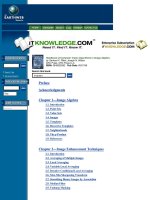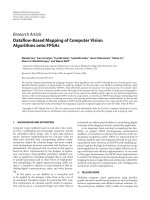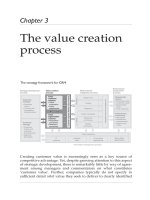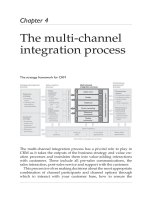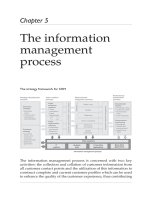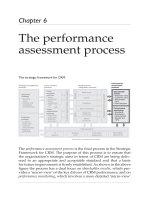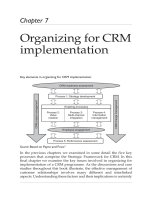ROBOTICS Handbook of Computer Vision Algorithms in Image Algebra Part 11 ppsx
Bạn đang xem bản rút gọn của tài liệu. Xem và tải ngay bản đầy đủ của tài liệu tại đây (711.95 KB, 17 trang )
Search Tips
Advanced Search
Handbook of Computer Vision Algorithms in Image Algebra
by Gerhard X. Ritter; Joseph N. Wilson
CRC Press, CRC Press LLC
ISBN: 0849326362 Pub Date: 05/01/96
Search this book:
Previous Table of Contents Next
Image Algebra Formulation
The exact formulation of a discrete correlation of an M × N image with a pattern p of size (2m - 1)
× (2n - 1) centered at the origin is given by
For (x + k, y + l) X, one assumes that a(x + k, y + l) = 0. It is also assumed that the pattern size is generally
smaller than the sensed image size. Figure 9.2.5 illustrates the correlation as expressed by Equation 9.2.1.
Figure 9.2.5 Computation of the correlation value c(x, y) at a point (x, y) X.
To specify template matching in image algebra, define an invariant pattern template t, corresponding to the
pattern p centered at the origin, by setting
The unnormalized correlation algorithm is then given by
The following simple computation shows that this agrees with the formulation given by Equation 9.2.1.
By definition of the operation •, we have that
Title
Since t is translation invariant, t
(x, y)
(u, v) = t
(0, 0)
(u - x, v - y). Thus, Equation 9.2.2 can be written as
Now t
(0, 0)
(u - x, v - y) = 0 unless (u - x, v - y) S(t
(0, 0)
) or, equivalently, unless -(m -1) d u - x d m - 1 and -(n -
1) d v - y d n - 1. Changing variables by letting k = u - x and l = v - y changes Equation 9.2.3 to
To compute the normalized correlation image c, let N denote the neighborhood function defined by N(y) =
S(t
y
). The normalized correlation image is then computed as
An alternate normalized correlation image is given by the statement
Note that £t
(0, 0)
is simply the sum of all pixel values of the pattern template at the origin.
Comments and Observations
To be effective, pattern matching requires an accurate pattern. Even if an accurate pattern exists, slight
variations in the size, shape, orientation, and gray level values of the object of interest will adversely affect
performance. For this reason, pattern matching is usually limited to smaller local features which are more
invariant to size and shape variations of an object.
9.3. Pattern Matching in the Frequency Domain
The purpose of this section is to present several approaches to template matching in the spectral or Fourier
domain. Since convolutions and correlations in the spatial domain correspond to multiplications in the
spectral domain, it is often advantageous to perform template matching in the spectral domain. This holds
especially true for templates with large support as well as for various parallel and optical implementations of
matched filters.
It follows from the convolution theorem [3] that the spatial correlation a•t corresponds to multiplication in the
frequency domain. In particular,
where â denotes the Fourier transform of a, denotes the complex conjugate of , and the inverse
Fourier transform. Thus, simple pointwise multiplication of the image â with the image
and Fourier
transforming the result implements the spatial correlation a •t.
One limitation of the matched filter given by Equation 9.3.1 is that the output of the filter depends primarily
on the gray values of the image a rather than on its spatial structures. This can be observed when considering
the output image and its corresponding gray value surface shown in Figure 9.3.2. For example, the letter E in
the input image (Figure 9.3.1) produced a high-energy output when correlated with the pattern letter B shown
in Figure 9.3.1. Additionally, the filter output is proportional to its autocorrelation, and the shape of the filter
output around its maximum match is fairly broad. Accurately locating this maximum can therefore be difficult
The image is now given by , the Fourier transform of p. The correlation image c can therefore be
obtained using the following algorithm:
Using the image p constructed in the above algorithm, the phase-only filter and the symmetric phase-only
filter have now the following simple formulation:
and
respectively.
Comments and Observations
In order to achieve the phase-only matching component to the matched filter approach we needed to divide
the complex image
by the amplitude image . Problems can occur if some pixel values of are equal to
zero. However, in the image algebra pseudocode of the various matched filters we assume that
, where denotes the pseudoinverse of . A similar comment holds for the quotient
.
Some further improvements of the symmetric phase-only matched filter can be achieved by processing the
spectral phases [6, 7, 8, 9].
9.4. Rotation Invariant Pattern Matching
In Section 9.2 we noted that pattern matching using simple pattern correlation will be adversely affected if the
pattern in the image is different in size or orientation then the template pattern. Rotation invariant pattern
matching solves this problem for patterns varying in orientation. The technique presented here is a digital
adaptation of optical methods of rotation invariant pattern matching [10, 11, 12, 13, 14].
Computing the Fourier transform of images and ignoring the phase provides for a pattern matching approach
that is insensitive to position (Section 9.3) since a shift in a(x, y) does not affect |â(u, v)|. This follows from
the Fourier transform pair relation
which implies that
where x
0
= y
0
= N/2 denote the midpoint coordinates of the N × N domain of â. However, rotation of a(x, y)
rotates |â(u, v)| by the same amount. This rotational effect can be taken care of by transforming |â(u, v)| to
polar form (u, v)
(r, ¸). A rotation of a(x, y) will then manifest itself as a shift in the angle ¸. After
determining this shift, the pattern template can be rotated through the angle ¸ and then used in one of the
standard correlation schemes in order to find the location of the pattern in the image.
The exact specification of this technique — which, in the digital domain, is by no means trivial — is provided
by the image algebra formulation below.
Previous Table of Contents Next
Products | Contact Us | About Us | Privacy | Ad Info | Home
Use of this site is subject to certain Terms & Conditions, Copyright © 1996-2000 EarthWeb Inc. All rights
reserved. Reproduction whole or in part in any form or medium without express written permission of
EarthWeb is prohibited. Read EarthWeb's privacy statement.
This step is vital for the success of the proposed method. Image spectra decrease rather rapidly as a function
of increasing frequency, resulting in suppression of high-frequency terms. Taking the logarithm of the Fourier
spectrum increases the amplitude of the side lobes and thus provides for more accurate results when
employing the symmetric phase-only filter at a later stage of this algorithm.
Step 5. Convert â and
to continuous image.
The conversion of â and
to continuous images is accomplished by using bilinear interpolation. An image
algebra formulation of bilinear interpolation can be found in [15]. Note that because of Step 4, â and
are
real-valued images. Thus, if â
b
and denote the interpolated images, then , where
That is, â
b
and are real-valued images over a point set X with real-valued coordinates.
Although nearest neighbor interpolation can be used, bilinear interpolation results in a more robust matching
algorithm.
Step 6. Convert to polar coordinates.
Define the point set
and a spatial function f : Y ’ X by
Next compute the polar images.
Step 7. Apply the SPOMF algorithm (Section 9.3).
Since the spectral magnitude is a periodic function of À and ¸ ranges over the interval [-À = ¸
0
, ¸
N
= À], the
output of the SPOMF algorithm will produce two peaks along the ¸ axis, ¸
j
and ¸
k
for some and
. Due to the periodicity, |¸
j
| + |¸
k
| = À and, hence, k = -(j + N/2). One of these two angles
corresponds to the angle of rotation of the pattern in the image with respect to the template pattern. The
complementary angle corresponds to the same image pattern rotated 180 °.
To find the location of the rotated pattern in the spatial domain image, one must rotate the pattern template (or
input image) through the angle ¸
j
as well as the angle ¸
k
. The two templates thus obtained can then be used in
one of the previous correlation methods. Pixels with the highest correlation values will correspond to the
pattern location.
Comments and Observations
The following example will help to further clarify the algorithm described above. The pattern image p and
input image a are shown in Figure 9.4.1. The exemplar pattern is a rectangle rotated through an angle of 15°
while the input image contains the pattern rotated through an angle of 70°. Figure 9.4.2 shows the output of
Step 4 and Figure 9.4.3 illustrates the conversion to polar coordinates of the images shown in Figure 9.4.2.
The output of the SPOMF process (before thresholding) is shown in Figure 9.4.4. The two high peaks appear
on the ¸ axis (r = 0).
Figure 9.4.1 The input image a is shown on the left and the pattern template p on the right.
The reason for choosing grid spacing
in Step 6 is that the maximum value of r is
which prevents mapping the polar coordinates outside the set X. Finer sampling grids
will further improve the accuracy of pattern detection; however, computational costs will increase
proportionally. A major drawback of this method is that it works best only when a single object is present in
the image, and when the image and template backgrounds are identical.
Figure 9.4.2 The log of the spectra of â (left) and (right).
Figure 9.4.3 Rectangular to polar conversion of â (left) and (right).
Figure 9.4.4 SPOMF of image and pattern shown in Figure 9.4.3.
9.5. Rotation and Scale Invariant Pattern Matching
In this section we discuss a method of pattern matching which is invariant with respect to both rotation and
scale. The two main components of this method are the Fourier transform and the Mellin transform. Rotation
invariance is achieved by using the approach described in Section 9.4. For scale invariance we employ the
Mellin transform. Since the Mellin transform
of an image a is given by
it follows that if b(x, y) = a(±x, ±y), then
Therefore,
which shows that the Mellin transform is scale invariant.
Implementation of the Mellin transform can be accomplished by use of the Fourier transform by rescaling the
input function. Specifically, letting ³ = logx and ² = logy we have
Therefore,
which is the desired result.
It follows that combining the Fourier and Mellin transform with a rectangular to polar conversion yields a
rotation and scale invariant matching scheme. The approach takes advantage of the individual invariance
properties of these two transforms as summarized by the following four basic steps:
(1) Fourier transform
(2) Rectangular to polar conversion
(3) Logarithmic scaling of r
(4) SPOMF
Previous Table of Contents Next
Products | Contact Us | About Us | Privacy | Ad Info | Home
Use of this site is subject to certain Terms & Conditions, Copyright © 1996-2000 EarthWeb Inc. All rights
reserved. Reproduction whole or in part in any form or medium without express written permission of
EarthWeb is prohibited. Read EarthWeb's privacy statement.
9.6. Line Detection Using the Hough Transform
The Hough transform is a mapping from into the function space of sinusoidal functions. It was first
formulated in 1962 by Hough [16]. Since its early formulation, this transform has undergone intense
investigations which have resulted in several generalizations and a variety of applications in computer vision
and image processing [1, 2, 17, 18, 19]. In this section we present a method for finding straight lines using the
Hough transform. The input for the Hough transform is an image that has been preprocessed by some type of
edge detector and thresholded (see Chapters 3 and 4). Specifically, the input should be a binary edge image.
Figure 9.5.4 SPOMF of image and pattern shown in Figure 9.5.3
A straight “line” in the sense of the Hough algorithm is a colinear set of points. Thus, the number of points in
a straight line could range from one to the number of pixels along the diagonal of the image. The quality of a
straight “line” is judged by the number of points in it. It is assumed that the natural straight lines in an image
correspond to digitized straight “lines” in the image with relatively large cardinality.
A brute force approach to finding straight lines in a binary image with N feature pixels would be to examine
all
possible straight lines between the feature pixels. For each of the possible lines, N - 2
tests for colinearity must be performed. Thus, the brute force approach has a computational complexity on the
order of N
3
. The Hough algorithm provides a method of reducing this computational cost.
To begin the description of the Hough algorithm, we first define the Hough transform and examine some of
its properties. The Hough transform is a mapping h from
into the function space of sinusoidal functions
defined by
To see how the Hough transform can be used to find straight lines in an image, a few observations need to be
made.
Any straight line l
0
in the xy-plane corresponds to a point (Á
0
, ¸
0
) in the Á¸-plane, where ¸
0
[0, À) and
. Let n
0
be the line normal to l
0
that passes through the origin of the xy-plane. The angle n
0
makes with the positive x-axis is ¸
0
. The distance from (0, 0) to l
0
along n
0
is |Á
0
|. Figure 9.6.1 below
illustrates the relation between l
0
, n
0
, ¸
0
, and Á
0
. Note that the x-axis in the figure corresponds to the point (0,
0), while the y-axis corresponds to the point (0, À/2).
Figure 9.6.1 Relation of rectangular to polar representation of a line.
Suppose (x
i
, y
i
), 1 d i d n, are points in the xy-plane that lie along the straight line l
0
(see Figure 9.6.1). The
line l
0
has a representation (Á
0
, ¸
0
) in the Á¸-plane. The Hough transform takes each of the points (x
i
, y
i
) to a
sinusoidal curve Á = x
i
cos(¸) + y
i
sin(¸) in the ¸Á-plane. The property that the Hough algorithm relies on is that
each of the curves Á = x
i
cos(¸) + y
i
sin(¸) have a common point of intersection, namely (Á
0
, ¸
0
). Conversely,
the sinusoidal curve Á = x cos(¸) + y sin(¸) passes through the point (Á
0
, ¸
0
) in the Á¸-plane only if (x, y) lies
on the line (Á
0
, ¸
0
) in the xy-plane.
As an example, consider the points (1, 7), (3, 5), (5, 3), and (6, 2) in the xy-plane that lie along the line l
0
with
¸ and Á representation and , respectively.
Figure 9.6.2 shows these points and the line l
0
.
Figure 9.6.2 Polar parameters associated with points lying on a line.
Previous Table of Contents Next
Products | Contact Us | About Us | Privacy | Ad Info | Home
Use of this site is subject to certain Terms & Conditions, Copyright © 1996-2000 EarthWeb Inc. All rights
reserved. Reproduction whole or in part in any form or medium without express written permission of
EarthWeb is prohibited. Read EarthWeb's privacy statement.
angle ¸. Each row in the accumulator represents a increment in Á. The cell location a(i, j) of the
accumulator is used as a counting bin for the point
in the Á¸-plane (and the
corresponding line in the xy-plane).
Initially, every cell of the accumulator is set to 0. The value a(i, j) of the accumulator is incremented by 1 for
every feature pixel (x, y) location at which the inequality
is satisfied, where and µ is an error factor used to compensate for
quantization and digitization. That is, if the point (Á
i
, ¸
j
) lies on the curve Á = x cos(¸) + y sin(¸) (within a
margin of error), the accumulator at cell location a(i, j) is incremented. Error analysis for the Hough transform
is addressed in Shapiro’s works [20, 21, 22].
When the process of incrementing cell values in the accumulator terminates, each cell value a(i, j) will be
equal to the number of curves Á = x cos(¸) + y sin(¸) that intersect the point (Á
i
, ¸
j
) in the Á¸-plane. As we
have seen earlier, this is the number of feature pixels in the image that lie on the line (Á
i
, ¸
j
).
The criterion for a good line in the Hough algorithm sense is a large number of colinear points. Therefore, the
larger entries in the accumulator are assumed to correspond to lines in the image.
Image Algebra Formulation
Let b {0, 1}
X
be the source image and let the accumulator image a be defined over Y, where
Define the parametrized template by
The accumulator image is given by the image algebra expression
Computation of this variant template sum is computationally intensive and inefficient. A more efficient
implementation is given below.
Previous Table of Contents Next
Products | Contact Us | About Us | Privacy | Ad Info | Home
Use of this site is subject to certain Terms & Conditions, Copyright © 1996-2000 EarthWeb Inc. All rights
reserved. Reproduction whole or in part in any form or medium without express written permission of
EarthWeb is prohibited. Read EarthWeb's privacy statement.
A straight line l
0
in the xy-plane can also be represented by a point (m
0
, c
0
), where m
0
is the slope of l
0
and c
0
is its y intercept. In the original formulation of the Hough algorithm [16], the Hough transform took points in
the xy-plane to lines in the slope-intercept plane; i.e., h : (x
i
, y
i
) ’ y
i
= mx
i
+ c. The slope intercept
representation of lines presents difficulties in implementation of the algorithm because both the slope and the
y intercept of a line go to infinity as the line approaches the vertical. This difficulty is not encountered using
the Á¸-representation of a line.
As an example, we have applied to the Hough algorithm to the thresholded edge image of a causeway with a
bridge (Figure 9.6.4). The Á¸-plane has been quantized using the 41 × 20 accumulator seen in Table 9.6.1.
Accumulator values greater than 80 were deemed to correspond to lines. Three values in the accumulator
satisfied this threshold, they are indicated within the accumulator by double underlining. The three detected
lines are shown in Figure 9.6.5.
The lines produced by our example probably are not the lines that a human viewer would select. A finer
quantization of ¸ and Á would probably yield better results. All the parameters for our example were chosen
arbitrarily. No conclusions on the performance of the algorithm should be drawn on the basis of our example.
It serves simply to illustrate an accumulator array. However, it is instructive to apply a straight edge to the
source image to see how the quantization of the Á¸-plane affected the accumulator values.
Figure 9.6.4 Source binary image.
Figure 9.6.5 Detected lines.
Table 9.6.1 Hough Space Accumulator Values
9.7. Detecting Ellipses Using the Hough Transform
The Hough algorithm can be easily extended to finding any curve in an image that can be expressed
analytically in the form f(x, p) = 0 [23]. Here, x is a point in the domain of the image and p is a parameter
vector. For example, the lines of Section 9.6 can be expressed in analytic form by letting g(x, p) = x cos(¸) + y
sin(¸) - Á, where p = (¸, Á) and
. We will first discuss how the Hough algorithm extends for
any analytic curve using circle location to illustrate the method.
The circle (x - Ç)
2
+ (y - È)
2
= Á
2
in the xy-plane with center (Ç, È) and radius Á can be expressed as f(x, p) =
(x - Ç)
2
+ (y - È)
2
- Á
2
= 0, where p = (Ç, È, Á). Therefore, just as a line l
0
in the xy-plane can parameterized
by an angle ¸
0
and a directed distance Á
0
, a circle c
0
in the xy-plane can be parametrized by the location of its
center (x
0
, y
0
) and its radius Á
0
.
The Hough transform used for circle detection is a map defined over feature points in the domain of the image
into the function space of conic surfaces. The Hough transform h used for circle detection is the map
Previous Table of Contents Next
Products | Contact Us | About Us | Privacy | Ad Info | Home
Use of this site is subject to certain Terms & Conditions, Copyright © 1996-2000 EarthWeb Inc. All rights
reserved. Reproduction whole or in part in any form or medium without express written permission of
EarthWeb is prohibited. Read EarthWeb's privacy statement.
Hough transform intersects the point (Ç
0
, È
0
, Á
0
) in ÇÈÁ-space. More generally, the point x
i
will lie on the
curve f(x, p
0
) = 0 in the domain of the image if and only if the curve f(x
i
, p) = 0 intersects the point p
0
in the
parameter space. Therefore, the number of feature points in the domain of the image that lie on the curve f(x,
p
0
) = 0 can be counted by counting the number of elements in the range of the Hough transform that intersect
p
0
.
As in the case of line detection, the parameter space must be quantized. The accumulator matrix is the
representation of the quantized parameter space. For circle detection the accumulator a will be a
three-dimensional matrix with all entries initially set to 0. The entry a(Ç
r
, È
s
, Á
t
) is incremented by 1 for
every feature point (x
i
, y
i
) in the domain of the image whose conic surface in ÇÈÁ-space passes through (Ç
r
,
È
s
, Á
t
). More precisely, a(Ç
r
, È
s
, Á
t
) is incremented provided
where µ is used to compensate for digitization and quantization. Shapiro [20, 21, 22] discusses error analysis
when using the Hough transform. If the above inequality holds, it implies that the conic surface (Ç - x
i
)
2
+ (È -
y
i
)
2
- Á = 0 passes trough the point (Ç
r
, È
s
, Á
t
) (within a margin of error) in ÇÈÁ space. This means the point
(x
i
, y
i
) lies on the circle (x - Ç
r
)
2
+ (y - È
s
)
2
- Á
t
= 0 in the xy-plane, and thus the accumulator value a(Ç
r
, È
s
,
Á
t
) should be incremented by 1.
Previous Table of Contents Next
Products | Contact Us | About Us | Privacy | Ad Info | Home
Use of this site is subject to certain Terms & Conditions, Copyright © 1996-2000 EarthWeb Inc. All rights
reserved. Reproduction whole or in part in any form or medium without express written permission of
EarthWeb is prohibited. Read EarthWeb's privacy statement.
It then follows by substituting for È in the original equation for the ellipse that
For ellipse detection we will assume that the original image has been preprocessed by a direction edge
detector and thresholded based on edge magnitude (Chapters 3 and 4). Therefore, we assume that an edge
direction image d [0, 2À)
X
exist, where X is the domain of the original image. The direction d(x, y) is the
direction of the gradient at the point (x, y) on the ellipse. The tangent to the ellipse at
. Since the gradient is perpendicular to the tangent, the following holds:
Figure 9.7.3 Parameters of an ellipse.
Recall that so far we have only been considering the equation for an ellipse whose axes are parallel to the axes
of the coordinate system. Different orientations of the ellipse corresponding to rotations of an angle ¸ about (
Ç, È) can be handled by adding a fifth parameter ¸ to the descriptors of an ellipse. This rotation factor
manifests itself in the expression for
, which becomes
With this edge direction and orientation information we can write Ç and È as
and
respectively.
The accumulator array for ellipse detection will be a five-dimensional array a. Every entry of a is initially set
to zero. For every feature point (x, y) of the edge direction image, the accumulator cell a(Ç
r
, È
s
, ¸
t
, ±
u
, ²
v
) is
incremented by 1 whenever
and
Larger accumulator entry values are assumed to correspond to better ellipses. If an accumulator entry is
judged large enough, its coordinates are deemed to be the parameters of an ellipse in the original image.
It is important to note that gradient information is used in the preceding description of an ellipse. As a
consequence, gradient information is used in determining whether a point lies on an ellipse. Gradient
information shows up as the term
in the equations that were derived above. The incorporation of gradient information improves the accuracy
and computational efficiency of the algorithm. Our original example of circle detection did not use gradient
information. However, circles are special cases of ellipses and circle detection using gradient information
follows immediately from the description of the ellipse detection algorithm.
Image Algebra Formulation
The input image b = (c, d) for the Hough algorithm is the result of preprocessing the original image by a
directional edge detector and thresholding based on edge magnitude. The image c {0, 1}
X
is defined by
The image d [0, 2À)
X
contains edge direction information.
Let
be the accumulator image, where
Let C(x, y, Ç, È, ¸, ±, ², µ
1
, µ
2
) denote the condition
Define the parameterized template t by
The accumulator array is constructed using the image algebra expression
Similar to the implementation of the Hough transform for line detection, efficient incrementing of
accumulator cells can be obtained by defining the neighborhood function N : Y ’ 2
X
by
The accumulator array can now be computed by using the following image algebra pseudocode:
Previous Table of Contents Next
Products | Contact Us | About Us | Privacy | Ad Info | Home
Use of this site is subject to certain Terms & Conditions, Copyright © 1996-2000 EarthWeb Inc. All rights
reserved. Reproduction whole or in part in any form or medium without express written permission of
EarthWeb is prohibited. Read EarthWeb's privacy statement.
